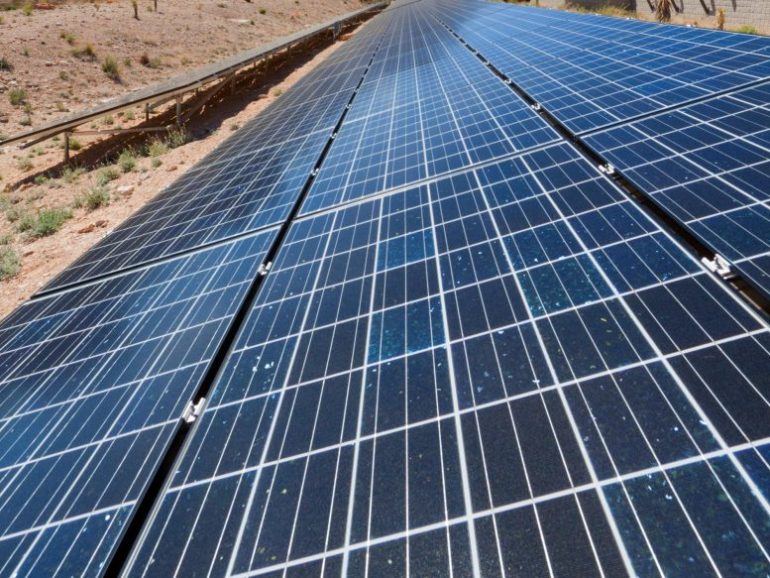UC Santa Cruz researchers published a new study—in collaboration with UC Water and the Sierra Nevada Research Institute at UC Merced—that suggests covering California’s 6,350 km network of public water delivery canals with solar panels could be an economically feasible means of advancing both renewable energy and water conservation.
The concept of “solar canals” has been gaining momentum around the world as climate change increases the risk of drought in many regions. Solar panels can shade canals to help prevent water loss through evaporation, and some types of solar panels also work better over canals, because the cooler environment keeps them from overheating.
Pilot projects in India have demonstrated the technical feasibility of several designs, but none have yet been deployed at scale. California’s canal network is the world’s largest water conveyance system, and the state faces both a drought-prone future and a rapid timeline for transitioning to renewable energy. Solar canals could target both challenges, but making the case for their implementation in California requires first quantifying the potential benefits. So that’s exactly what researchers set out to do in their paper published by Nature Sustainability.
“While it makes sense to cover canals with solar panels because renewable energy and water conservation is a win-win, the devil is in the details,” said Brandi McKuin, lead author of the new study and a UC Santa Cruz postdoctoral researcher in environmental studies. “A critical question was whether the infrastructure to span the canals would be cost-prohibitive.”
Canal-spanning solar panels are often supported either by steel trusses or suspension cables, both of which are more expensive to build than traditional support structures for ground-mounted solar panels. But McKuin led a techno-economic analysis that showed how the benefits of solar canals combine to outweigh the added costs for cable-supported installations. In fact, cable-supported solar canals showed a 20-50 percent higher net present value, indicating greater financial return on investment.
In addition to benefits like increased solar panel performance and evaporation savings, shade from solar panels could help control the growth of aquatic weeds, which are a costly canal maintenance issue. Placing solar panels over existing canal sites could also avoid costs associated with land use. Now that the new paper has provided a more concrete assessment of these benefits, members of the research team hope this could lead to future field experiments with solar canals in California.
“This study is a very important step toward encouraging investments to produce renewable energy while also saving water,” said Roger Bales, a coauthor on the paper who is a distinguished professor of engineering at UC Merced, the former director of the Sierra Nevada Research Institute, and a director at UC Water.
Bales was part of the original group that got the project started in 2016, when San Francisco-based social impact agency Citizen Group partnered with UC Solar and UC Water to develop the concept. From there, the research grew into a collaboration between UC Merced and UC Santa Cruz.
Lead author Brandi McKuin started working on the project while completing her Ph.D. at Merced, then continued with help from senior author and UCSC professor Elliott Campbell, the Stephen R. Gliessman Presidential Chair in Water Resources and Food Systems and a fellow Merced transplant. UC Merced professor Joshua Viers and researcher Tapan Pathak advised on the project, and graduate students Andrew Zumkehr and Jenny Ta contributed to analysis.
Zumkehr led a complex hydrological analysis using data from satellites, climate models, and automated weather stations to model and compare evaporation rates at canal sites across the state, with and without shade from solar panels. McKuin then used this information in her assessment to calculate the financial benefits of reduced evaporation.
Ultimately, it was the cost savings of many combined benefits that made solar canals financially viable, rather than benefits from reduced evaporation alone. But the study also notes that benefits from deploying solar canals could extend beyond immediate financial impacts. For example, every megawatt of solar energy produced by solar canals in California’s Central Valley has the potential to replace 15-20 diesel-powered irrigation pumps, helping to reduce pollution in a region with some of the nation’s worst air quality.
And senior author Elliott Campbell says the wide range of benefits identified by the paper is, in itself, an important lesson to carry forward. He sees the findings as not only an assessment of solar canals, but also a clear illustration of the interconnections between urgent global issues like air quality, energy, and water conservation.
“What we’re seeing here is actually some surprising benefits when you bring water and energy together,” Campbell said. “Sometimes it leads to a smoother landing in how we transition to better ways of making energy and saving water.”
20 overlooked benefits of distributed solar energy
More information:
Energy and water co-benefits from covering canals with solar panels, Nature Sustainability (2021). DOI: 10.1038/s41893-021-00693-8
Provided by
University of California – Santa Cruz
Citation:
New analysis shows potential for ‘solar canals’ in California (2021, March 18)
retrieved 18 March 2021
from https://techxplore.com/news/2021-03-analysis-potential-solar-canals-california.html
This document is subject to copyright. Apart from any fair dealing for the purpose of private study or research, no
part may be reproduced without the written permission. The content is provided for information purposes only.



